During their final month aboard the International Space Station (ISS), the Expedition 1 crew of NASA astronaut William M. Shepherd and Russian cosmonauts Yuri P. Gidzenko and Sergei K. Krikalev continued to commission the orbiting laboratory, conducted some early research, and contended with a balky treadmill. They took their Soyuz spacecraft for a short flight around the space station to free up a docking port for a Progress cargo resupply ship. On March 10, 2001, the space shuttle Discovery arrived on the STS-102 mission, with NASA astronauts Commander James D. Wetherbee, Pilot James M. Kelly, and Mission Specialists Andrew S.W. Thomas, and Paul W. Richards, bringing supplies to the station inside the Leonardo Multi-Purpose Logistics Module (MPLM). Accompanying them for the launch and the trip to the station, the Expedition 2 crew of Russian cosmonaut Yuri V. Usachev and NASA astronauts James S. Voss and Susan J. Helms replaced Shepherd, Gidzenko, and Krikalev as the lab’s new occupants, completing the first crew exchange of the ISS program.
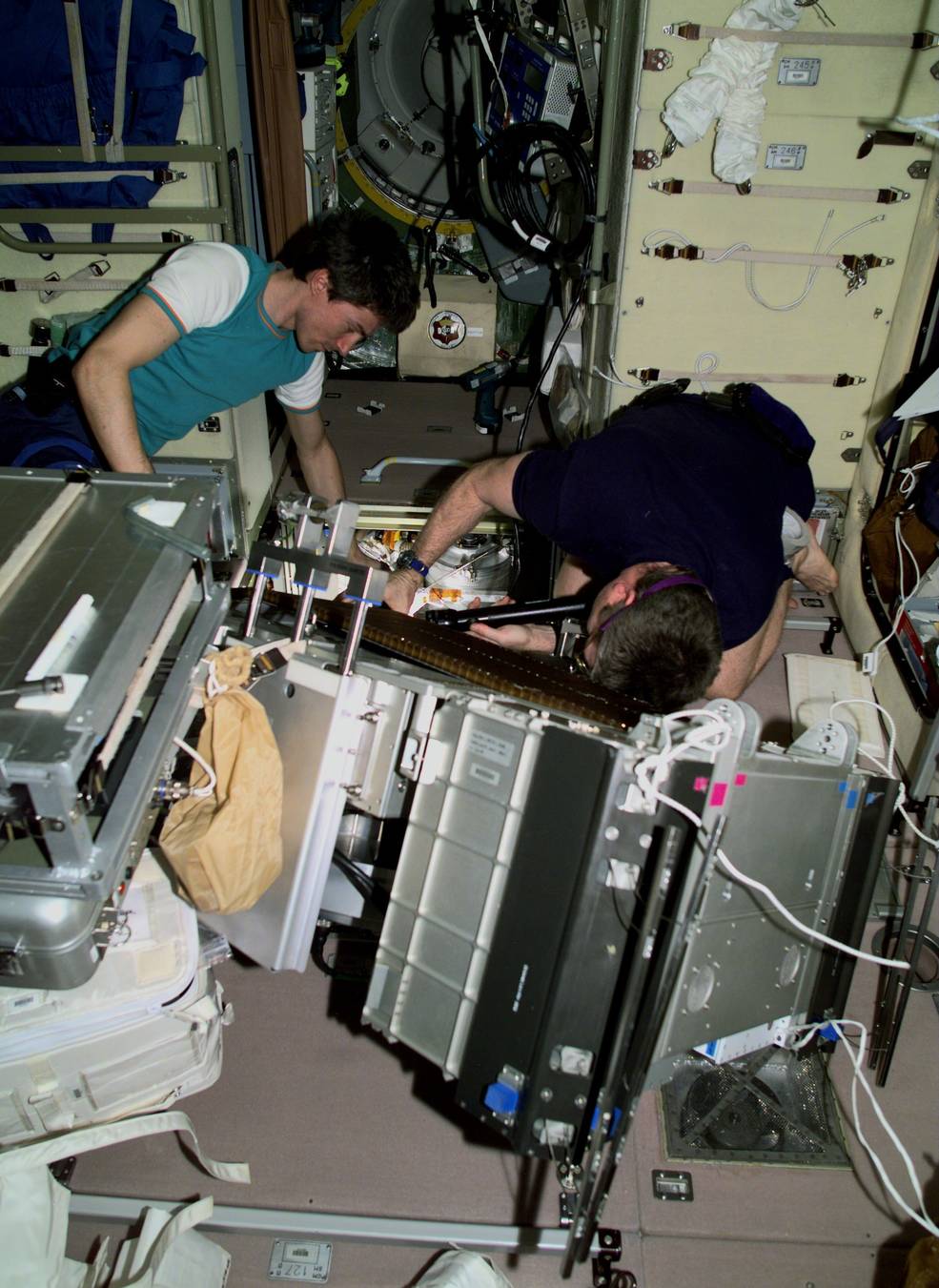
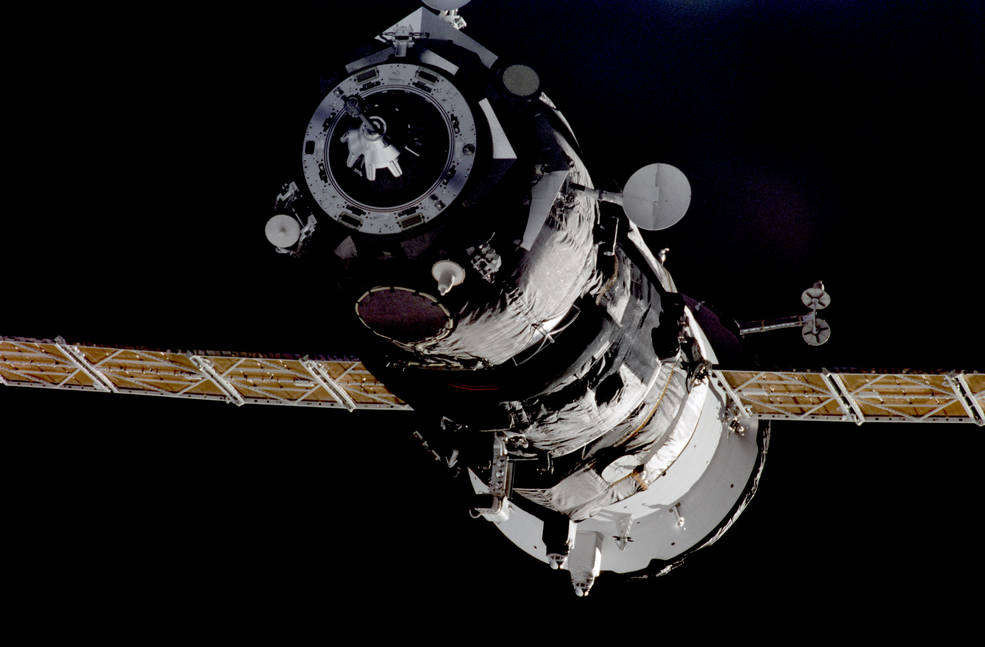
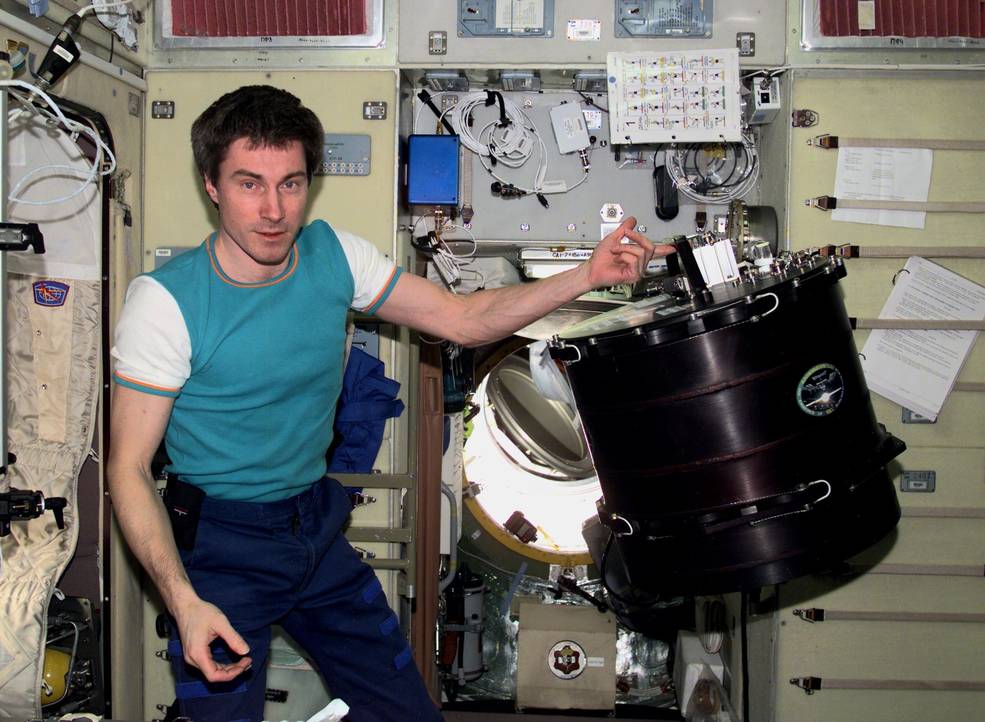
Left: Sergei K. Krikalev, left, and William M. Shepherd working to repair the treadmill in the Zvezda Service Module. Middle: Image of a Progress cargo resupply vehicle approaching the International Space Station (ISS). Right: Krikalev “lifting” with one finger the 110-pound Plasma Kristal-3 Nefedov experiment in Zvezda.
Following the departure of the STS-98 crew aboard space shuttle Atlantis on Feb. 16, 2001, Shepherd, Gidzenko, and Krikalev continued the commissioning of the newly expanded orbital laboratory. The onboard treadmill, required for their daily exercise, proved the most troublesome equipment, requiring frequent and time-consuming maintenance and repair. On Feb. 23, they boarded their Soyuz TM31 spacecraft and undocked from the Zvezda Service Module’s aft port. In a flight lasting about 30 minutes, Gidzenko maneuvered the spacecraft and redocked at the Zarya module’s Earth-facing port. The relocation freed up the aft port for the arrival of Progress M44 on Feb. 28, bringing supplies and the Plasma Kristal-3 (PK-3) experiment, renamed PK3-Nefedov after the sudden death of Anatoli P. Nefedov, the project’s scientist at the Institute for High Energy Densities in Moscow just two weeks before the experiment arrived at the ISS. Krikalev and Gidzenko set up the hardware and completed several experiment sessions. Then the crew focused on greeting their next visitors, including their replacements aboard the ISS, and on returning to Earth.
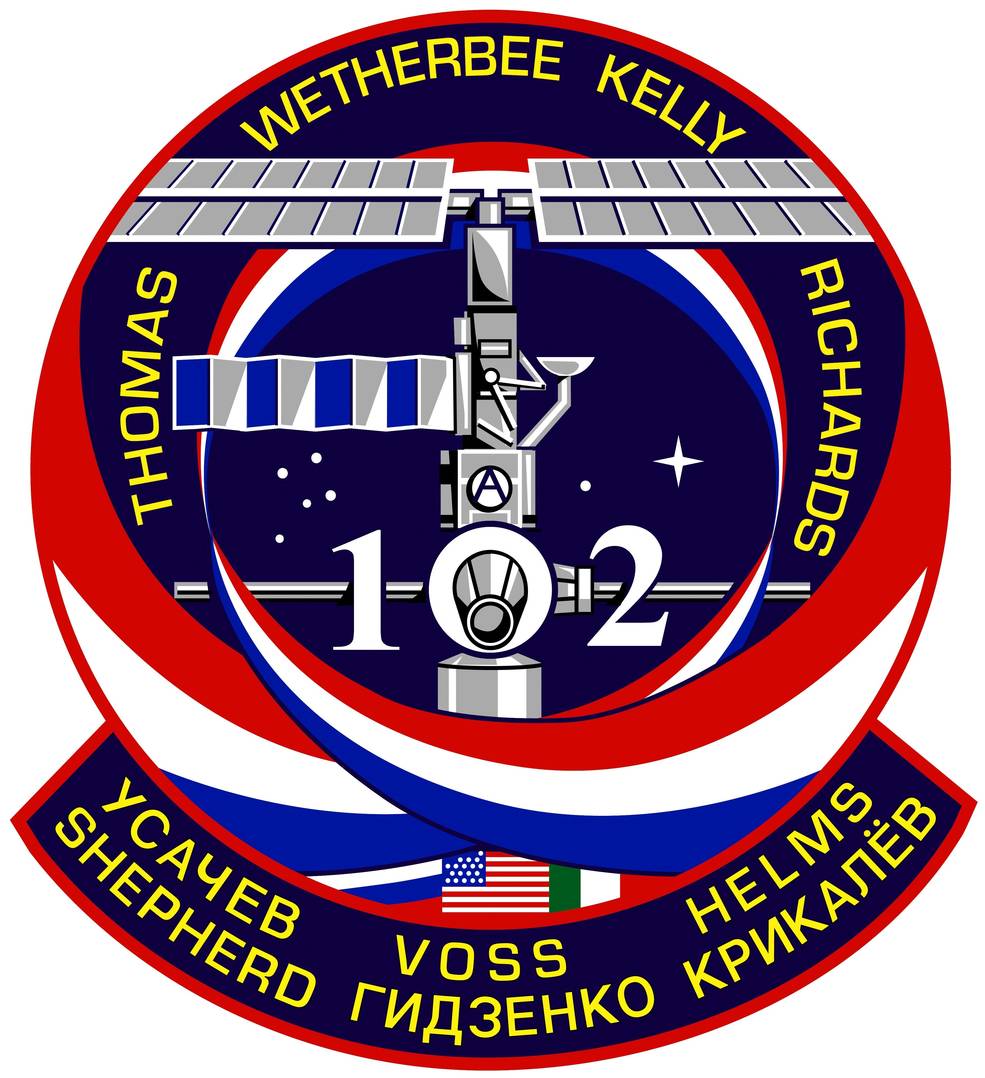
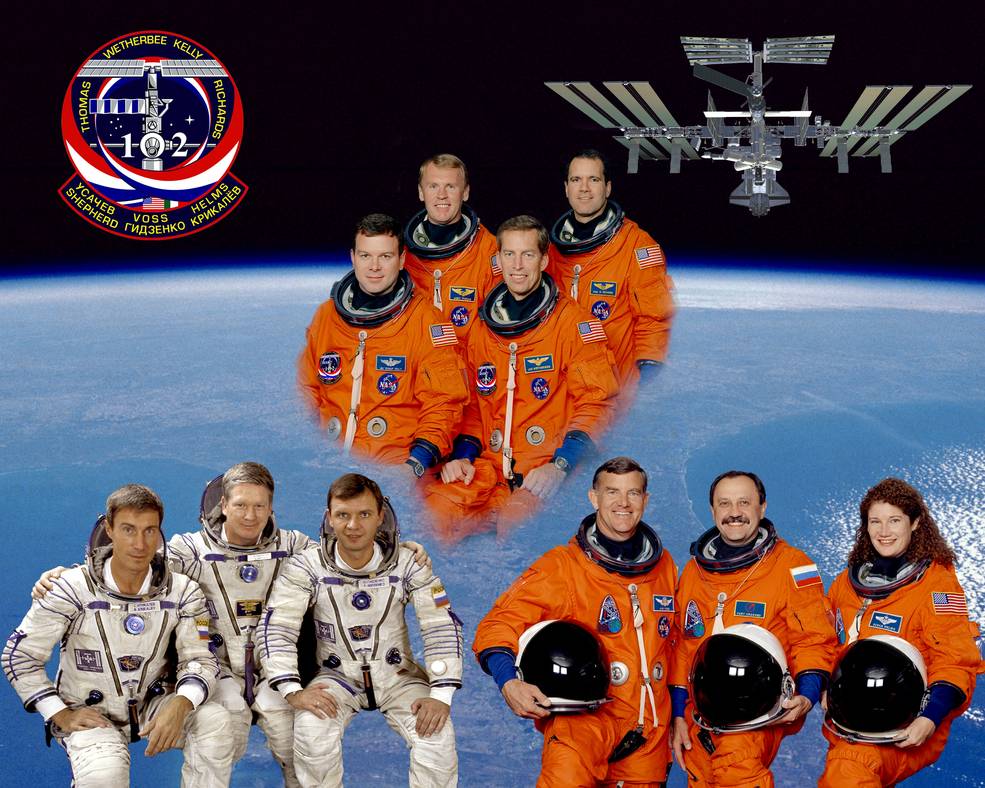
Left: The STS-102 crew patch. Right: STS-102 crew, at top James M. Kelly, left, Andrew S.W. Thomas, James D. Wetherbee, and Paul W. Richards; lower left, Expedition 1 crew members Sergei K. Krikalev, left, William M. Shepherd, and Yuri P. Gidzenko; lower right, Expedition 2 crew members James S. Voss, left, Yuri V. Usachev, and Susan J. Helms.
The eighth space shuttle assembly and resupply mission to the ISS, STS-102, began on the morning of March 8, 2001, with the launch of space shuttle Discovery from Launch Pad 39B at NASA’s Kennedy Space Center in Florida. Less than two days later, Wetherbee guided Discovery to a smooth docking with the station at the Pressurized Mating Adapter-2, or PMA-2, located on the forward end of the U.S. Laboratory module Destiny. The Expedition 1 crew observed the rendezvous and docking, and four hours later, the astronauts opened the hatches between Discovery and the ISS. The first of the crew exchanges took place that day, a well-choreographed sequence that included transfers of Soyuz suits and seat liners, with Usachev replacing Gidzenko as an ISS crew member.
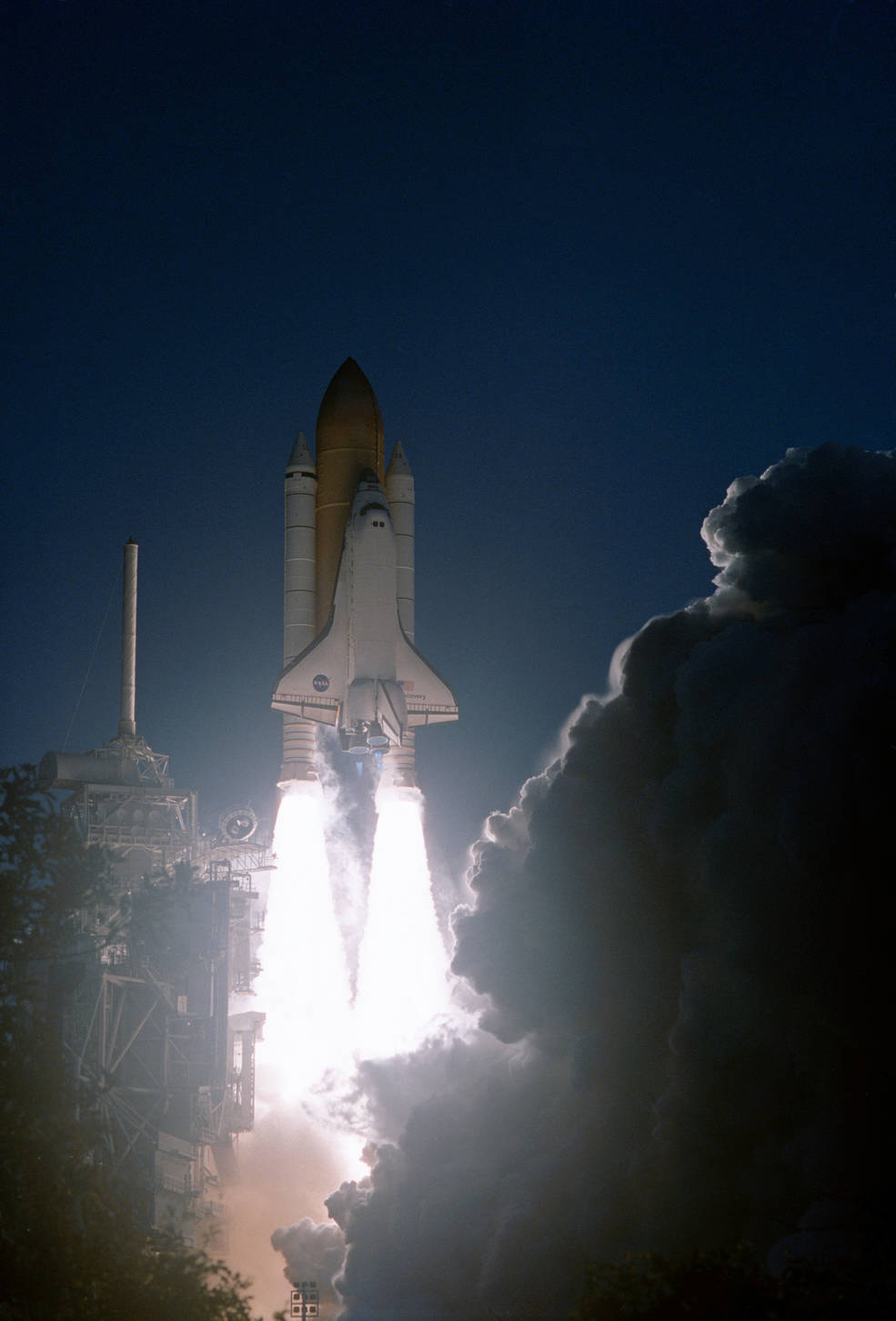
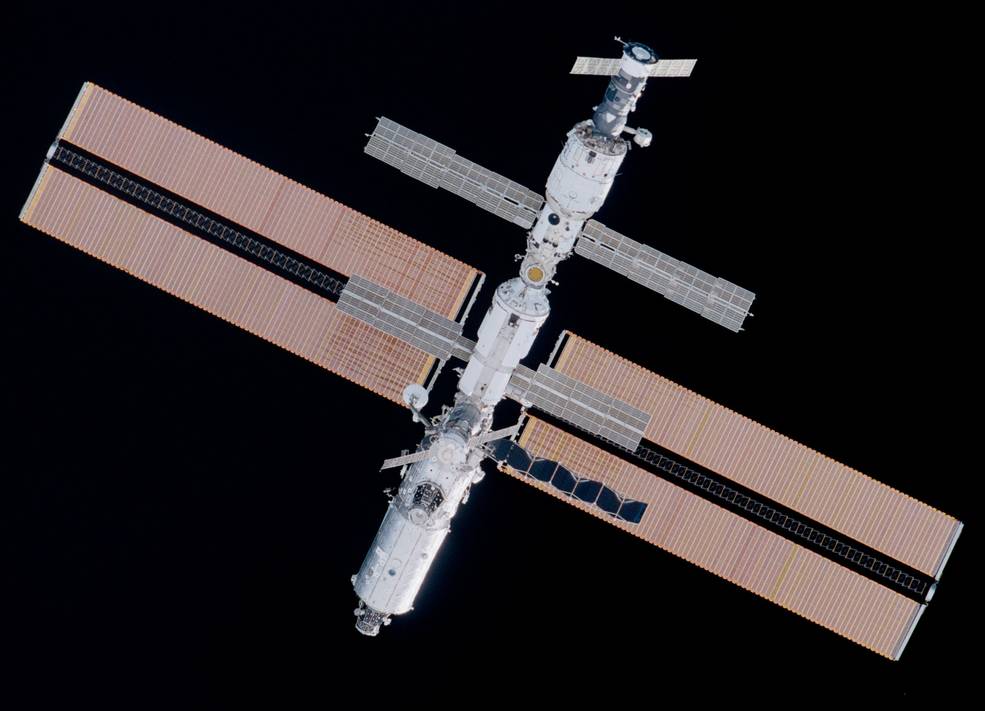
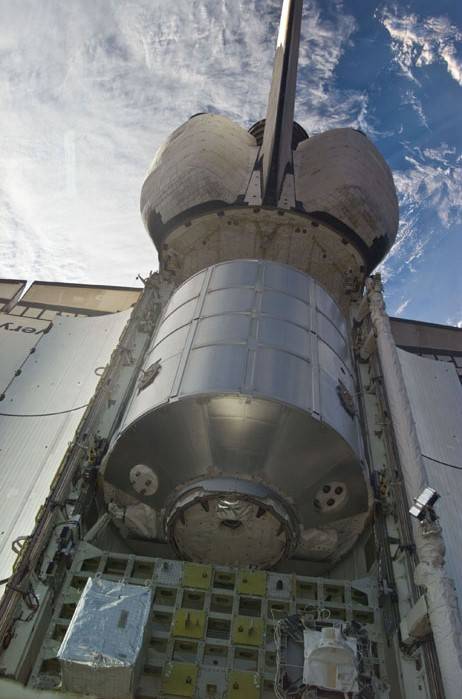
Left: Launch of Discovery on space shuttle mission STS-102. Middle: View of the International Space Station (ISS) from Discovery during the rendezvous and docking maneuver. Right: View from inside the ISS of space shuttle Discovery with the Leonardo Multi-Purpose Logistics Module in the payload bay.
The following day, the fourth of the STS-102 mission, Voss and Helms exited the shuttle’s airlock to begin the flight’s first spacewalk. Although they accomplished many tasks, Voss and Helms’ primary goal was to prepare the PMA-3 to be relocated from Node 1’s Earth-facing port to one of its side ports, allowing for the later installation of the MPLM. Voss and Helms concluded the spacewalk after 8 hours 56 minutes, the longest spacewalk to date. After returning inside, Voss became an Expedition 2 crew member after swapping places with Krikalev.
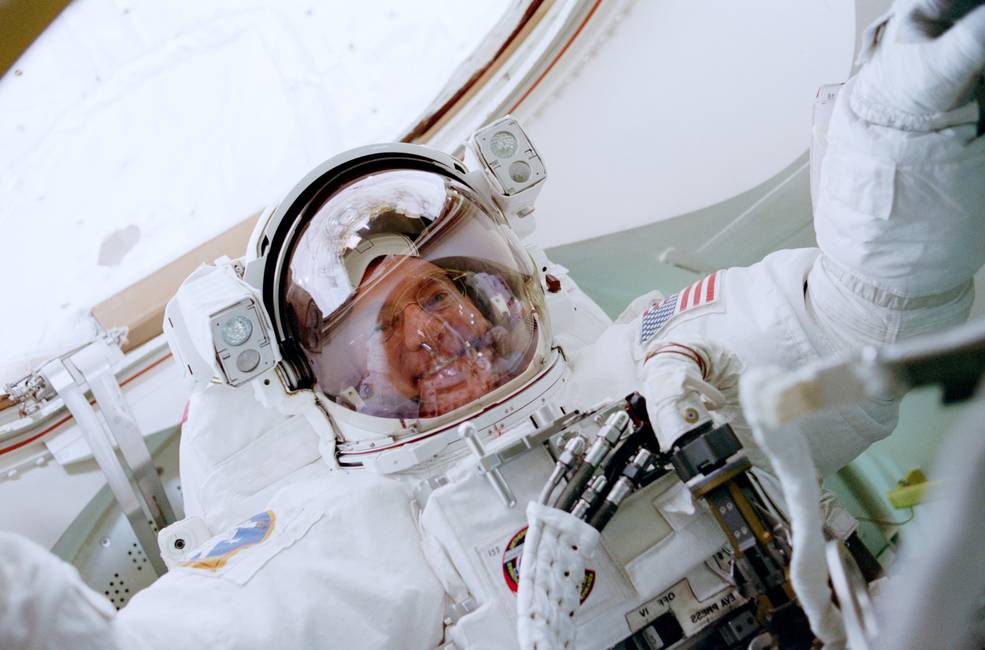
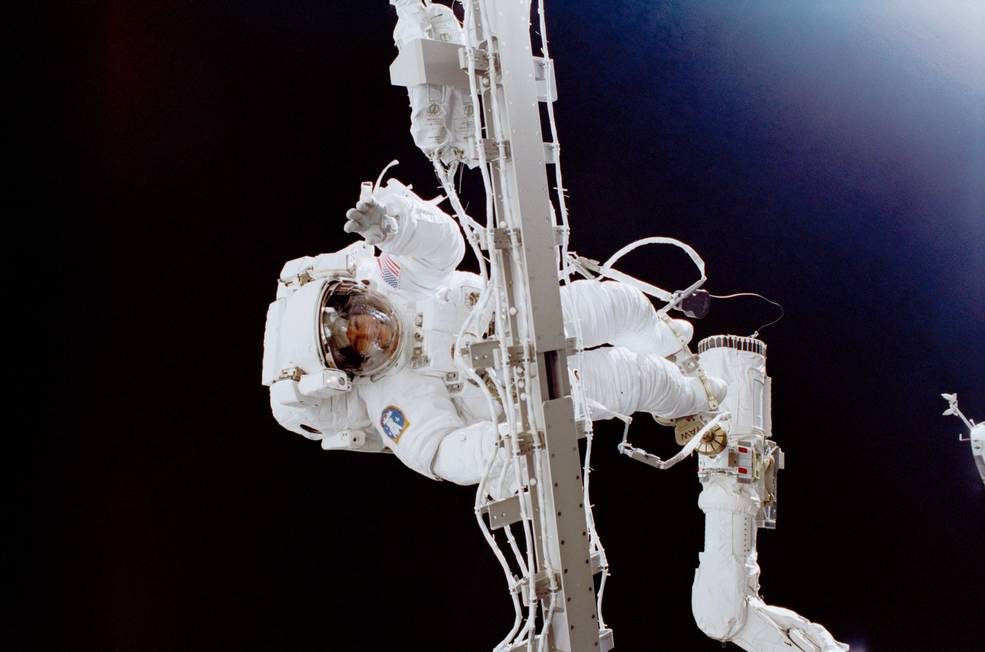
STS-102 (later Expedition 2) crew members James S. Voss, left, and Susan J. Helms during the first STS-102 spacewalk, the longest spacewalk to date.
The crew focused on installing the MPLM onto the ISS and on internal activities. Using the shuttle’s remote manipulator system (RMS) or robotic arm, Thomas lifted the 20,000-pound Leonardo out of the payload bay and slowly transferred it to the Unity Node 1’s Earth-facing port. After completing pressure equalization checks, Shepherd opened the hatch to the MPLM, and the crew began to transfer the 9,000 pounds of cargo into the ISS. The items included six systems racks to complete the Destiny module’s operational outfitting and seven resupply racks of stowed items. Also transferred, the Human Research Facility Rack 1, the first science facility to be installed in Destiny. To prepare for the rack’s activation and operations and for round-the-clock research activities, the Payload Operations and Integration Center (POIC) at NASA’s Marshall Space Flight Center in Huntsville, Alabama, became operational March 17. The POIC has served as the nerve center for all NASA research activities aboard the ISS for more than 20 years.
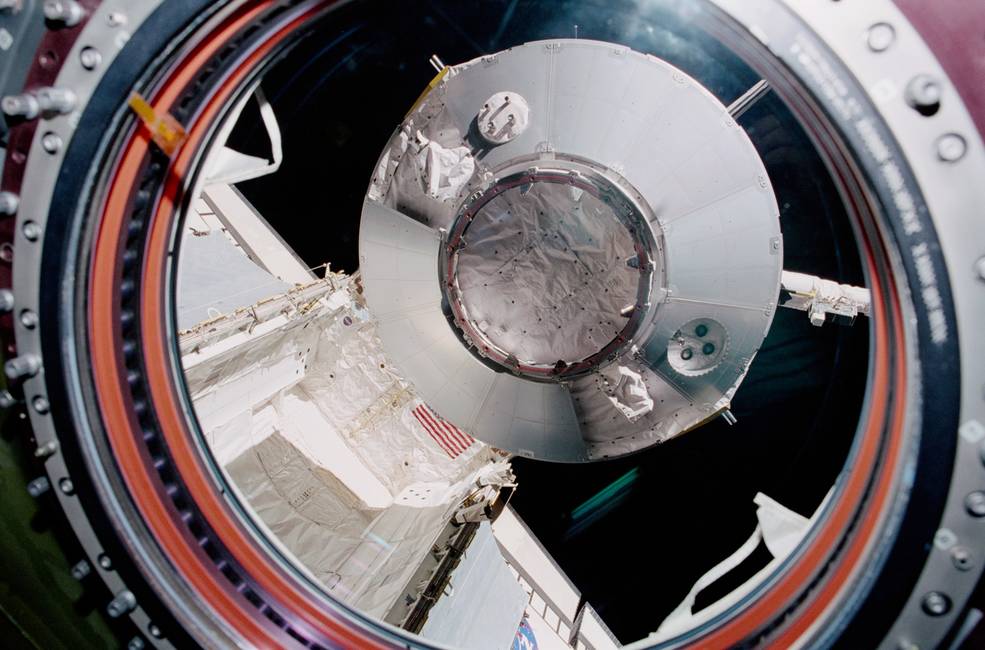
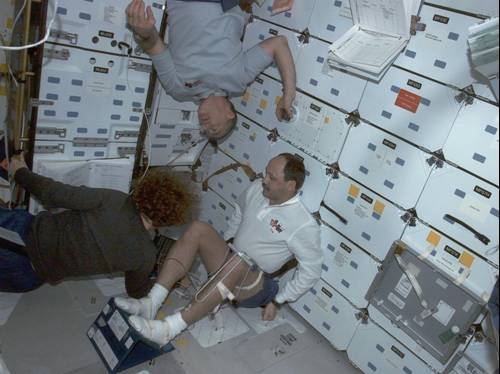
Left: The Leonardo Multi-Purpose Logistics Module seen through the U.S. Laboratory module’s window during its installation onto the Node 1 Unity module. Right: Expedition 2 cosmonaut Yuri V. Usachev, lower right, participating in a neuromuscular experiment in the shuttle Discovery’s middeck, assisted by fellow Expedition 2 astronauts Susan J. Helms, left, and James S. Voss.
As internal transfers continued on the mission’s sixth day, Thomas and Richards conducted the second spacewalk. During the 6-hour 21-minute excursion, they installed an external stowage platform to store space station spare parts, an extra ammonia coolant pump, and cables to supply power to heaters for the Canadian robotic arm scheduled for delivery on the following shuttle flight.
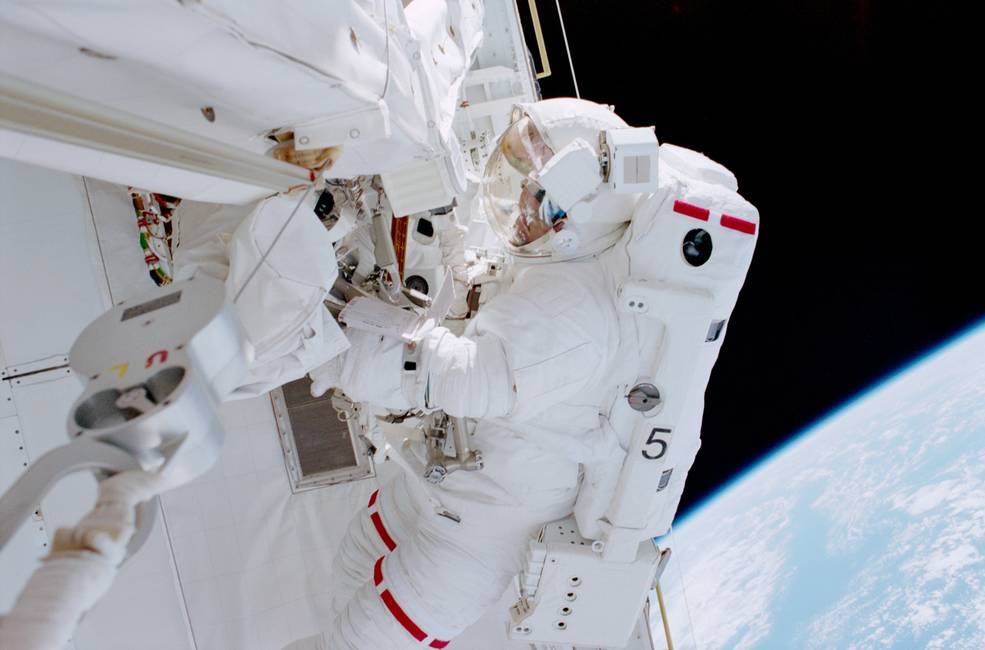
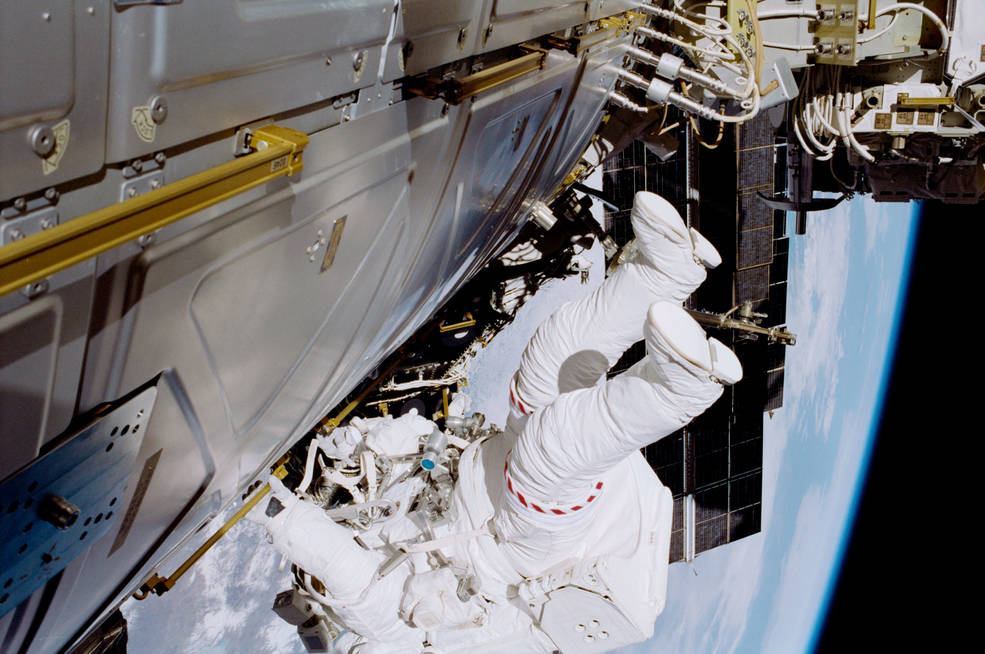
STS-102 astronauts Andrew S.W. Thomas (left) and Paul D. Richards during the second STS-102 spacewalk.
Over the next several days, the crews continued the transfer of cargo to the ISS, and once complete, they filled the MPLM with unused equipment and trash for return to Earth. Helms and Shepherd swapped places, completing the first crew rotation at the ISS. Mission managers added an extra day to the mission to ease the heavy burden on the crew members to allow for the completion of the planned tasks.
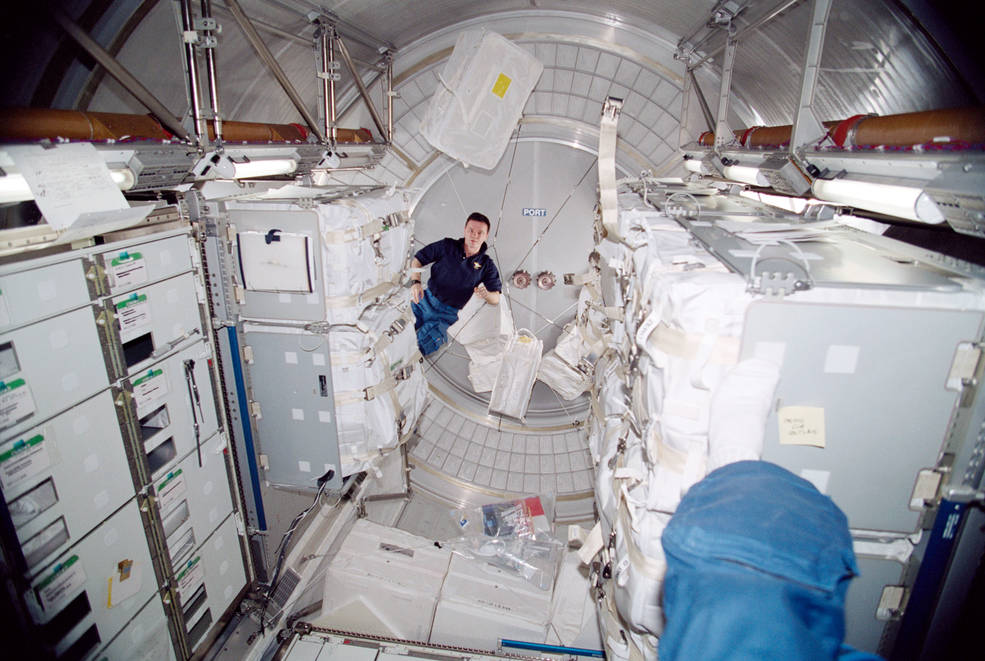
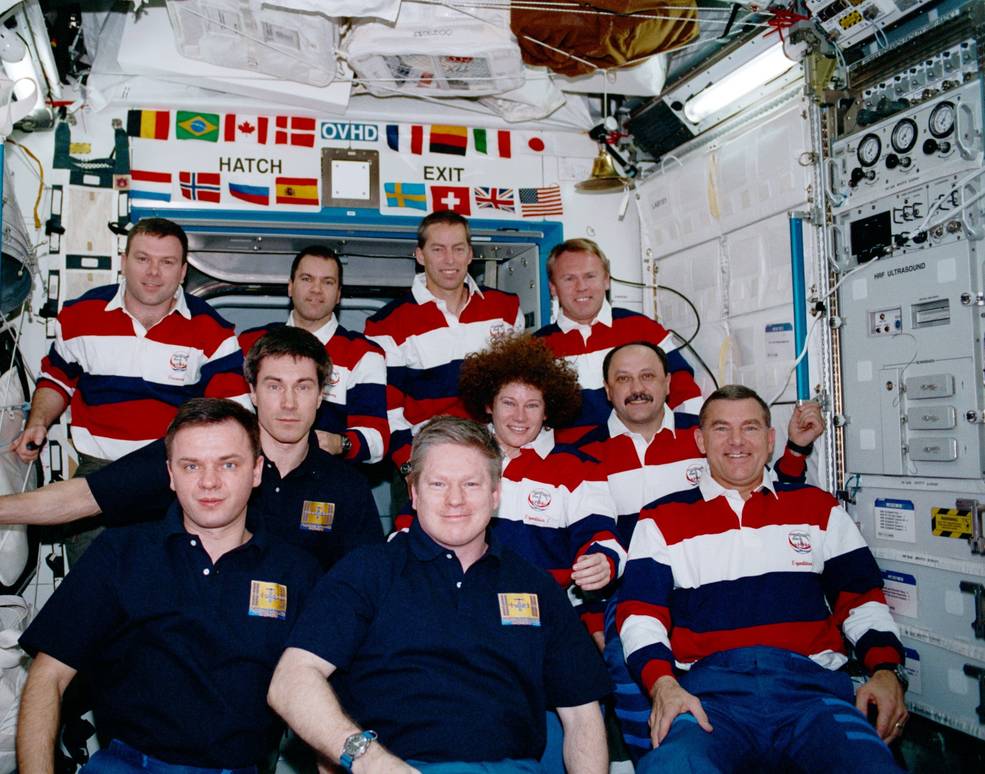
Left: Yuri P. Gidzenko inside the Leonardo Multi-Purpose Logistics Module showing its large capacity. Right: The combined STS-102 and Expedition 1 and 2 crews in the Destiny U.S. Laboratory module.
After the MPLM was filled, on March 18, the crew closed its hatch, and Thomas grappled the module with the RMS, removed it from the Node 1, and returned it into the shuttle’s payload bay. The next day, following naval tradition, Shepherd held a change of command ceremony, formally handing command of the ISS to Expedition 2 cosmonaut Usachev, handing over the ship’s log as well. The time-honored tradition has continued for 20 years. On March 13, with Kelly at the controls, space shuttle Discovery undocked from the ISS after spending nearly nine days together and performed a fly-around of the station to assess its condition. Then Kelly fired Discovery’s thrusters to begin the final separation between the two spacecraft.
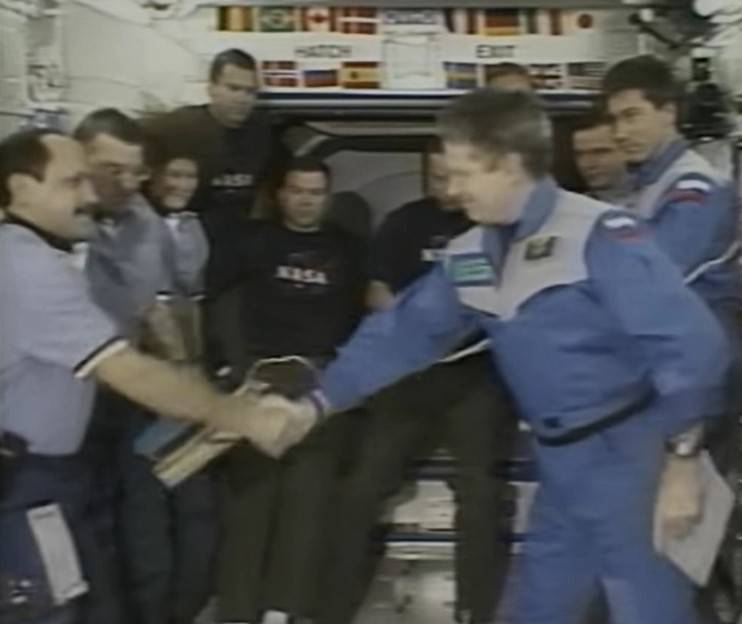
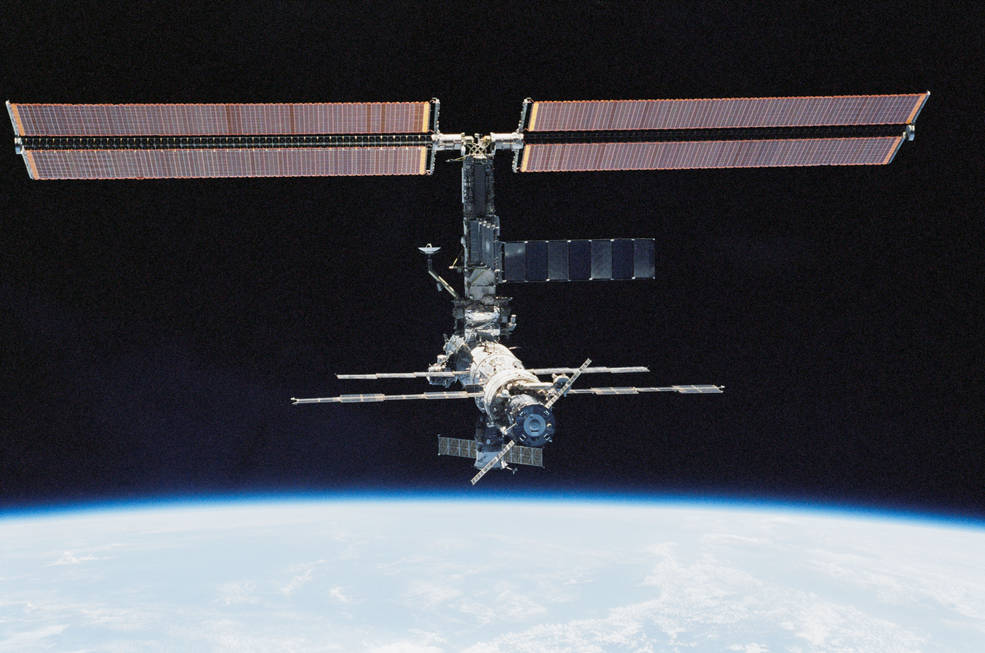
Left: During the first change of command ceremony aboard the International Space Station (ISS), Expedition 2 Commander Yuri V. Usachev accepts command of the facility from Expedition 1 Commander William M. Shepherd. Right: The ISS as seen by the STS-102 crew after its departure.
Discovery spent two more days in orbit. On March 21, the crew prepared for the journey back to Earth. Shepherd, Gidzenko, and Krikalev, possibly deconditioned after their four months in space, strapped into recumbent couches on Discovery’s middeck, instead of the usual upright seats, to minimize the impacts of returning to a gravity environment. Wetherbee fired Discovery’s maneuvering engines to drop them out of orbit and steered the shuttle to a smooth night landing at KSC. The shuttle crew had spent 12 days, 13 hours in space while the Expedition 1 crew returned after 141 days, having activated the ISS and opened it for long-term operations and research.
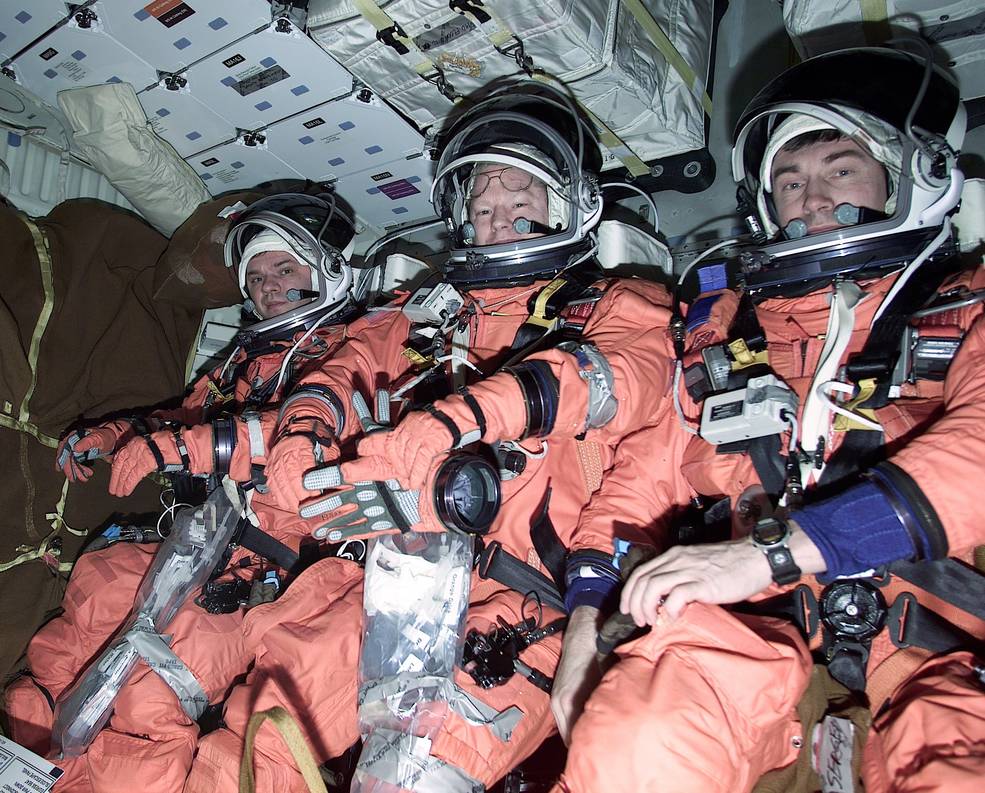
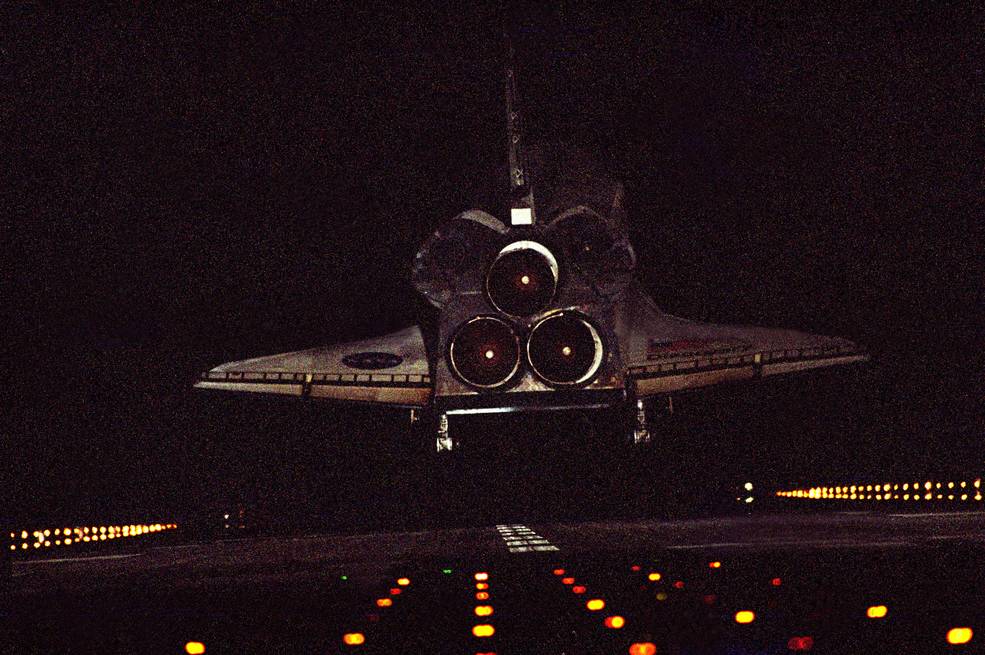
Left: Returning Expedition 1 crew members Yuri P. Gidzenko, left, William M. Shepherd, and Sergei K. Krikalev in their recumbent couches in space shuttle Discovery’s middeck in preparation for reentry and landing. Right: Space shuttle Discovery makes a night landing at NASA’s Kennedy Space Center.
The day after landing, the entire crew returned to Houston’s Ellington Field near NASA’s Johnson Space Center, where they were met by center management and fellow astronauts. At a public reception in an airplane hangar, each of the astronauts and cosmonauts shared their impressions of the historic mission just completed and the longer mission just begun. That mission continues today.
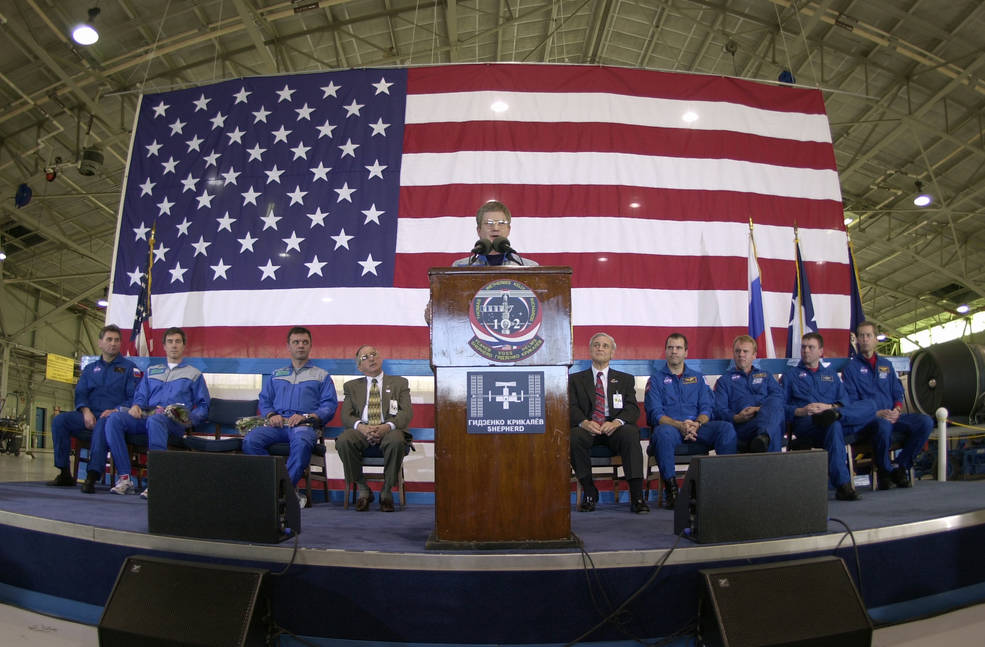
Expedition 1 commander William M. Shepherd addresses a welcome home crowd assembled at Ellington Field in Houston, as Vasili V. Tsibliev, deputy director of the Gagarin Cosmonaut Training Center in Star City, Russia, Expedition 1 cosmonauts Sergei K. Krikalev and Yuri P. Gideznko, Joseph H. Rothenberg, NASA Associate Administrator for Space Flight at NASA Headquarters, acting director of NASA’s Johnson Space Center Roy S. Estess, and STS-102 astronauts Paul W. Richards, Andrew S.W. Thomas, James M. Kelly, and James D. Wetherbee look on. Image credit: Bill Ingalls.
Enjoy the crew-narrated video about the STS-102 mission.


























